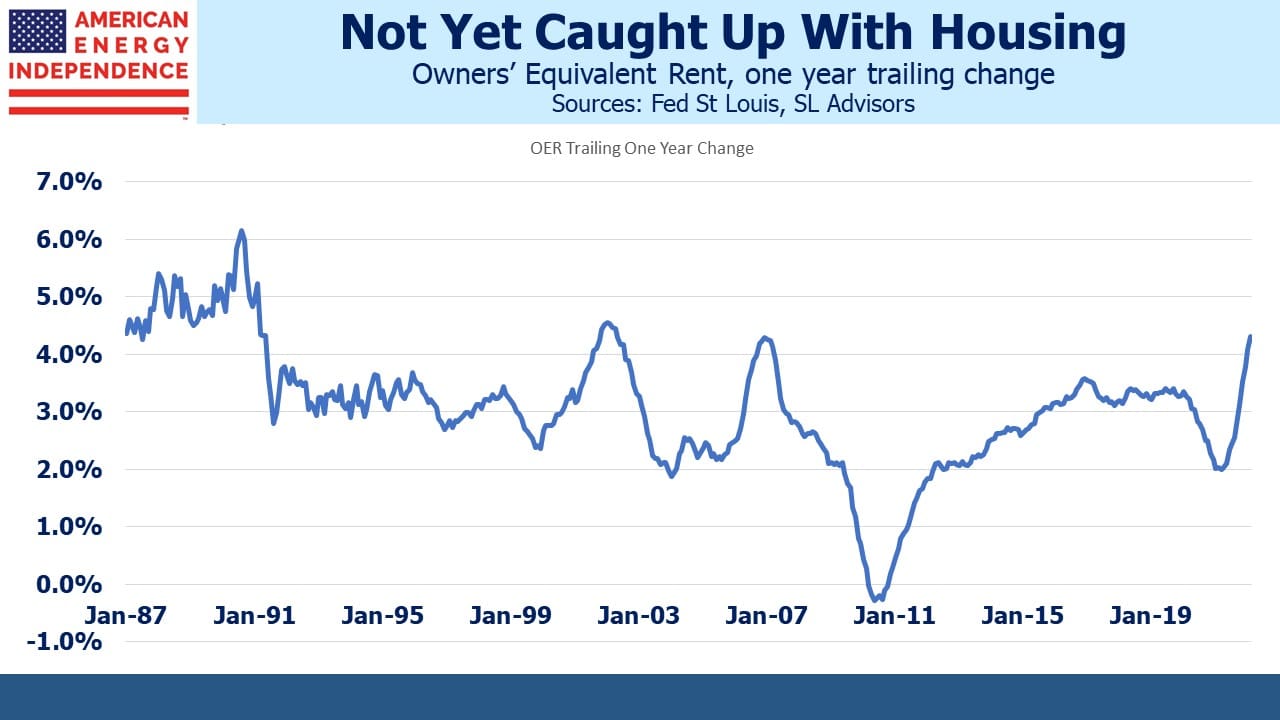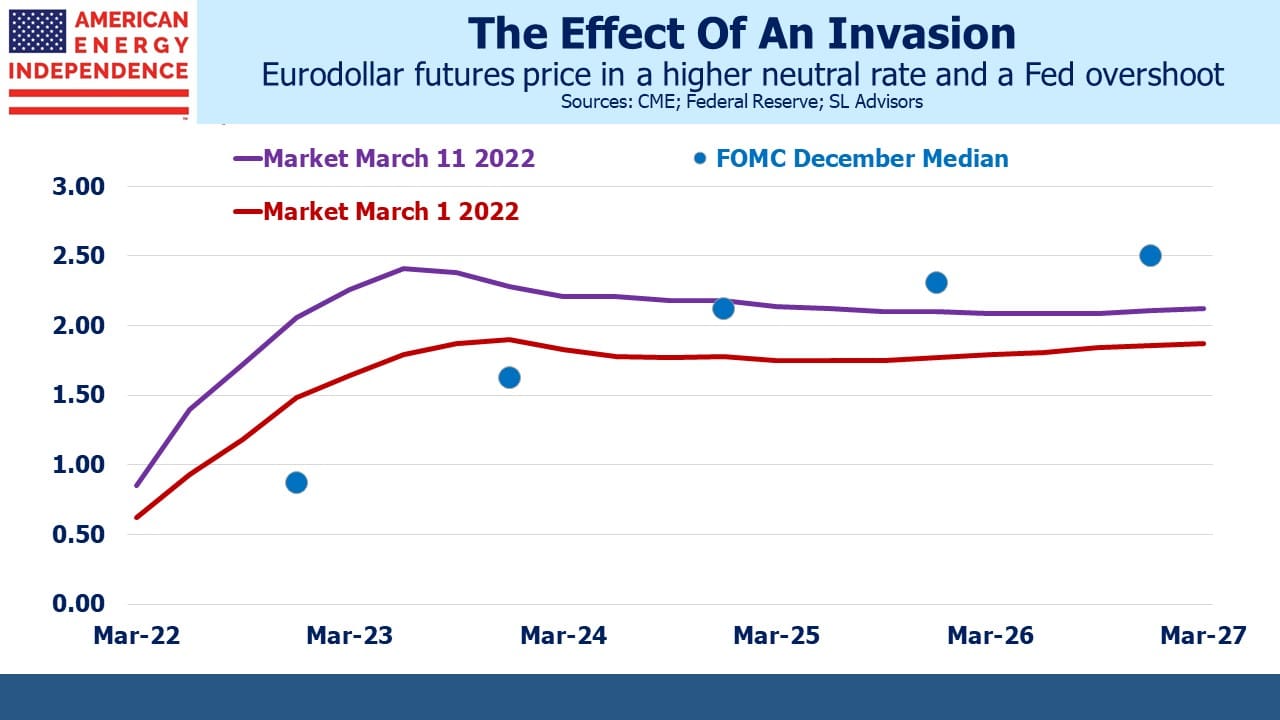How Far Will The Fed Go?
Next week the Fed Funds rate is expected to be raised, for the first time in over three years. Pundits love to say the Federal Reserve is “in a corner”, implying a Hobson’s Choice between possible courses of action. This hackneyed term is being deployed again, mischaracterizing their choices.
It’s true inflation expectations have edged up – five years implied CPI is 3.4%, and ten years 2.9%. But these figures aren’t that bad – if inflation runs at 7% this year, falls to 4% next year and then returns to the Fed’s 2% long term target, that would be consistent with the 3.4% average implied by the treasury market. Moreover, the Personal Consumption Expenditures (PCE) deflator which is the Fed’s chosen metric typically runs 0.25% or so below CPI. Although inflation is 7.9%, the FOMC can interpret long-run expectations as well contained.
Higher crude oil is both a constraint on consumer spending and a boost to inflation. These factors prescribe opposite pressures on monetary policy – higher oil works like a tax hike without the corresponding improvement in our fiscal balance. Leaning hard against current inflation makes less sense when energy prices are already tempering disposable incomes.
The justification for monetary accommodation receded long ago, and the FOMC will want to get back to neutral probably at the pace implied by eurodollar futures – reaching 2% in a year or so.
The interesting question is in which direction is this forecast vulnerable? Goldman Sachs puts the odds of a recession by next year at 20-35%, which they calculate is the odds implied by the yield curve. The market’s priced for the Fed to modestly over-tighten by the end of next year, causing them to reverse course.
The bond market is being tugged between these two opposing forces – increased odds of recession and rising inflation.
Although crude oil fell last week, the supply shock to a broad range of commodities caused by Russia’s invasion looks set to persist. It’s hard to envisage a scenario in Ukraine that will restore Russia’s trading links with much of the world. Regardless of the military outcome, diversity of supply is now a pillar of European energy security and probably food security too.
As commodity prices continue to reflect tight markets, recession odds and inflation will both increase.
For an FOMC attuned to “transitory” explanations for elevated inflation, there is a long list of candidates, even if chair Jay Powell has officially retired the adjective. Supply constraints as consumption of goods rebounded faster than services was the original one. Putin’s gas price hike is another that White House press secretary Jenn Psaki has coined. Tighter monetary policy isn’t much help there.
The energy transition is inflationary – properly executed it means energy will cost more without doing more. Administration policy has been to discourage new supply of traditional energy, which was already pushing prices higher before Putin provided another shove. If Russia’s isolation from global trade continues for many months, which seems likely, this will dominate the narrative around energy inflation.
Then there’s Owners’ Equivalent Rent (OER), the deeply flawed estimate of the cost of shelter based on survey responses measuring what homeowners think they could rent their house for (see Why You Shouldn’t Expect A Return To 2% Inflation). This metric lagged the strong housing market that followed Covid, providing the BLS economists who publish it and the FOMC to ignore what American home buyers experienced.
OER does tend to track the Case Shiller index over the long run, and has recently been trending higher (+4.3% year-on-year). Surveyed homeowners are belatedly reflecting the strong housing market by demanding more theoretical rent from their hypothetical tenants. Having ignored the housing market, as OER pushed up measured inflation the FOMC could dismiss it as a non-cash expense. It would be bizarre for monetary policy to be influenced by OER – it never has been. Housing bubbles have never induced higher short term rates, and there’s no reason to expect OER to either.
OER is another item on the list of inflation that can be tolerated. Having dropped “transitory” look out for “ephemeral” or “impermanent” as replacement adjectives.
The yield curve can be interpreted as the market’s way of grading the Fed. Too steep suggests they’re allowing too much inflation. Inversion suggests policy is too tight. They want to get back to neutral, which is 2.5% although 2% would be close enough. Given this FOMC’s full employment bias and inflation risk tolerance, we’re only ever one weak payroll report away from the market repricing to a slower pace of policy normalization.
Eurodollar futures suggest a cycle peak late next year. The impact of Russia’s invasion has been to shift the neutral rate higher and increase the odds of an overshoot. If the FOMC ever finds themselves contemplating a rate hike when the market is priced for it to be their last, many members will be find reasons to demur. This is why ten year inflation expectations should continue moving up. Portfolios should be structured accordingly.
We have three funds that seek to profit from this environment:
Please see important Legal Disclosures.
Important Disclosures
The information provided is for informational purposes only and investors should determine for themselves whether a particular service, security or product is suitable for their investment needs. The information contained herein is not complete, may not be current, is subject to change, and is subject to, and qualified in its entirety by, the more complete disclosures, risk factors and other terms that are contained in the disclosure, prospectus, and offering. Certain information herein has been obtained from third party sources and, although believed to be reliable, has not been independently verified and its accuracy or completeness cannot be guaranteed. No representation is made with respect to the accuracy, completeness or timeliness of this information. Nothing provided on this site constitutes tax advice. Individuals should seek the advice of their own tax advisor for specific information regarding tax consequences of investments. Investments in securities entail risk and are not suitable for all investors. This site is not a recommendation nor an offer to sell (or solicitation of an offer to buy) securities in the United States or in any other jurisdiction.
References to indexes and benchmarks are hypothetical illustrations of aggregate returns and do not reflect the performance of any actual investment. Investors cannot invest in an index and do not reflect the deduction of the advisor’s fees or other trading expenses. There can be no assurance that current investments will be profitable. Actual realized returns will depend on, among other factors, the value of assets and market conditions at the time of disposition, any related transaction costs, and the timing of the purchase. Indexes and benchmarks may not directly correlate or only partially relate to portfolios managed by SL Advisors as they have different underlying investments and may use different strategies or have different objectives than portfolios managed by SL Advisors (e.g. The Alerian index is a group MLP securities in the oil and gas industries. Portfolios may not include the same investments that are included in the Alerian Index. The S & P Index does not directly relate to investment strategies managed by SL Advisers.)
This site may contain forward-looking statements relating to the objectives, opportunities, and the future performance of the U.S. market generally. Forward-looking statements may be identified by the use of such words as; “believe,” “expect,” “anticipate,” “should,” “planned,” “estimated,” “potential” and other similar terms. Examples of forward-looking statements include, but are not limited to, estimates with respect to financial condition, results of operations, and success or lack of success of any particular investment strategy. All are subject to various factors, including, but not limited to general and local economic conditions, changing levels of competition within certain industries and markets, changes in interest rates, changes in legislation or regulation, and other economic, competitive, governmental, regulatory and technological factors affecting a portfolio’s operations that could cause actual results to differ materially from projected results. Such statements are forward-looking in nature and involves a number of known and unknown risks, uncertainties and other factors, and accordingly, actual results may differ materially from those reflected or contemplated in such forward-looking statements. Prospective investors are cautioned not to place undue reliance on any forward-looking statements or examples. None of SL Advisors LLC or any of its affiliates or principals nor any other individual or entity assumes any obligation to update any forward-looking statements as a result of new information, subsequent events or any other circumstances. All statements made herein speak only as of the date that they were made. r
Certain hyperlinks or referenced websites on the Site, if any, are for your convenience and forward you to third parties’ websites, which generally are recognized by their top level domain name. Any descriptions of, references to, or links to other products, publications or services does not constitute an endorsement, authorization, sponsorship by or affiliation with SL Advisors LLC with respect to any linked site or its sponsor, unless expressly stated by SL Advisors LLC. Any such information, products or sites have not necessarily been reviewed by SL Advisors LLC and are provided or maintained by third parties over whom SL Advisors LLC exercise no control. SL Advisors LLC expressly disclaim any responsibility for the content, the accuracy of the information, and/or quality of products or services provided by or advertised on these third-party sites.
All investment strategies have the potential for profit or loss. Different types of investments involve varying degrees of risk, and there can be no assurance that any specific investment will be suitable or profitable for a client’s investment portfolio.
Past performance of the American Energy Independence Index is not indicative of future returns.





Leave a Reply
Want to join the discussion?Feel free to contribute!